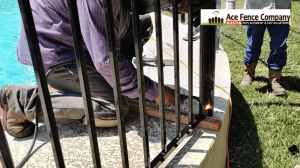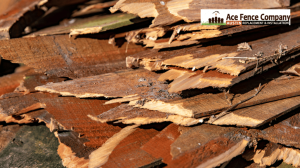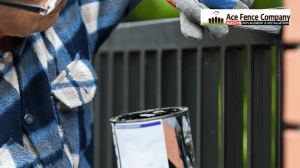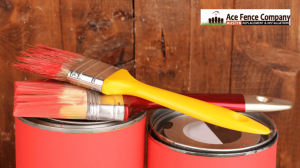Fence maintenance is often overlooked in favor of more immediate home improvement tasks, but it plays a crucial role in preserving your property’s boundary and aesthetic. At Ace Fence Company, we understand the importance of regular upkeep to ensure your fence remains durable and visually appealing. Knowing how to maintain and extend the life of your fence can save you from costly repairs and replacements down the road.
Different fence material options come with their own maintenance requirements. Wood fences need regular sealing or staining to prevent rot, while vinyl fences are low-maintenance and require occasional cleaning. Metal fences, like wrought iron, benefit from rust prevention treatments. Composite fences offer the best of both worlds with minimal upkeep and long-lasting durability.
By taking the time to care for your fence, you can significantly extend its lifespan. Whether you have a wood, vinyl, or metal fence, learning proper maintenance techniques ensures it continues to enhance your property’s security and curb appeal for years to come. Ace Fence Company is here to guide you through the best practices for keeping your fence in top shape.
Table of Contents
ToggleWhat is fence maintenance, and why is it important?
 Maintenance entails regular fence inspections, cleaning, repairs, and protective treatments to safeguard your fence’s longevity and aesthetic appeal. It’s vital because it wards off premature wear and tear, offering long-term savings and efficiency for homeowners. Proper upkeep boosts curb appeal and ensures your fence continues to fulfill its role in providing privacy and security.
Maintenance entails regular fence inspections, cleaning, repairs, and protective treatments to safeguard your fence’s longevity and aesthetic appeal. It’s vital because it wards off premature wear and tear, offering long-term savings and efficiency for homeowners. Proper upkeep boosts curb appeal and ensures your fence continues to fulfill its role in providing privacy and security.
Addressing issues such as rot, damage, or instability promptly can significantly extend your fence’s life, preserving its functionality and appearance. This routine care is indispensable across all fence types—wood, vinyl, metal, or composite—each demanding tailored maintenance strategies to counter their specific vulnerabilities.
How to inspect your fence regularly
Regularly inspecting your fence is key to early identification of potential issues, preventing them from worsening. Begin by searching for signs of rot, damage, or insect infestation, which can undermine the structure’s integrity. Inspect for loose or missing boards and hardware, which are critical for the fence’s stability. Evaluate the stability of posts and support structures, ensuring they are firmly anchored and undamaged. This proactive approach facilitates timely repairs, preserving the fence’s condition and functionality.
Look for signs of rot, damage, or insect infestation.
Inspect your fence for any signs of rot, damage, or evidence of insect infestation. These conditions can undermine the integrity and longevity of your fence, making early detection and intervention crucial.
Check for loose or missing boards and hardware.
Examine your fence for loose or missing boards and hardware. These issues can affect both the fence’s stability and its aesthetic appeal. Tightening or replacing compromised components is essential to maintain the structure’s integrity and functionality.
Assess the stability of posts and support structures.
Check the stability of your fence’s posts and supporting structures. They should be securely anchored and undamaged. Unstable posts can jeopardize the entire fence’s stability, potentially leading to more significant repairs if not addressed promptly.
Cleaning your fence
 Maintaining a clean fence is crucial for extending its lifespan and enhancing visual appeal. Start by removing dirt, grime, and mildew with a soft brush, a gentle yet effective way to protect the surface from damage. Utilize appropriate cleaners tailored to your fence’s material—be it wood, vinyl, or metal—to ensure compatibility and prevent harmful reactions.
Maintaining a clean fence is crucial for extending its lifespan and enhancing visual appeal. Start by removing dirt, grime, and mildew with a soft brush, a gentle yet effective way to protect the surface from damage. Utilize appropriate cleaners tailored to your fence’s material—be it wood, vinyl, or metal—to ensure compatibility and prevent harmful reactions.
Conclude cleaning by rinsing thoroughly with a garden hose, and avoiding power washers, which can be overly aggressive and cause harm. This cleaning regimen keeps your fence looking its best and facilitates early detection of any maintenance needs.
Remove dirt, grime, and mildew with a soft brush.
Start cleaning by gently removing dirt, grime, and mildew using a soft brush. This method is effective and gentle, ensuring the fence’s surface is preserved while achieving a deep clean.
Use appropriate cleaners for wood, vinyl, or metal fences.
Employ cleaners specifically designed for your type of fence—whether wood, vinyl, or metal. Choosing the proper cleaning solution is essential to avoid damage and ensure the fence’s longevity.
Rinse thoroughly with a garden hose, not a power washer.
Conclude by thoroughly rinsing the fence with a garden hose. Avoiding power washers as their high pressure can cause unnecessary damage, stripping away protective coatings and weakening the fence’s structure.
Applying protective coatings
Applying protective coatings is a crucial aspect of fence maintenance, pivotal in enhancing your fence’s durability and aesthetic appeal. Applying paint or stain every 2-3 years for wood fences rejuvenates its appearance and acts as a shield against moisture and decay. Metal fences gain extended life and maintain structural integrity from a sealant that wards off rust. Vinyl fences, known for their low maintenance, can still suffer from fading; a UV protectant helps preserve their vibrant color and prevent brittleness. By selecting and applying the appropriate protective coatings, you significantly boost your fence’s resilience to environmental elements and wear, ensuring it continues to serve as a robust, attractive boundary for many years.
Paint or stain for wood fences every 2-3 years
Rejuvenate and protect your wood fence by applying paint or stain every 2-3 years. This essential maintenance step not only boosts its visual appeal but also acts as a protective barrier against moisture and decay, significantly extending the lifespan of your fence.
Sealant for metal fences to prevent rust
Protect your metal fence from the elements by applying a sealant to prevent rust. This critical layer of protection preserves the fence’s structural integrity and aesthetic by warding off corrosion, ensuring its strength and appearance are maintained over time.
UV protectant for vinyl fences to prevent fading
Preserve the vibrant look of your vinyl fence with a UV protectant. This preventative measure combats fading and brittleness caused by sun exposure, keeping the fence’s color bright and material resilient for years.
Repairing damages promptly
 Promptly repairing damages is essential for upholding your fence’s structural integrity and aesthetics. Taking immediate action to replace damaged boards or sections not only rejuvenates the fence’s look but also halts further deterioration. Tightening or replacing loose hardware is critical for ensuring the fence’s stability and security. Filling small holes or cracks can also ward off water ingress, preventing subsequent damage. By addressing repairs without delay, you can circumvent more extensive, costly fixes down the line, effectively prolonging the life and preserving the function and beauty of your fence.
Promptly repairing damages is essential for upholding your fence’s structural integrity and aesthetics. Taking immediate action to replace damaged boards or sections not only rejuvenates the fence’s look but also halts further deterioration. Tightening or replacing loose hardware is critical for ensuring the fence’s stability and security. Filling small holes or cracks can also ward off water ingress, preventing subsequent damage. By addressing repairs without delay, you can circumvent more extensive, costly fixes down the line, effectively prolonging the life and preserving the function and beauty of your fence.
Replace damaged boards or sections to maintain integrity.
Act swiftly to replace any damaged boards or sections, which is a critical move to maintain the integrity of your fence. This prevents further deterioration and ensures the fence remains strong and visually appealing.
Tighten or replace loose hardware to ensure stability.
Ensure the stability of your fence by tightening or replacing any loose hardware. This step is essential for the fence’s functionality and safety, keeping it secure against the forces of nature and use.
Fill small holes or cracks to prevent water ingress.
Prevent water ingress by filling small holes or cracks as soon as they are noticed. This preventative action helps to avert more significant damage, such as rot and mold, safeguarding the fence’s condition and longevity.
Preventing moisture damage
 Preventing moisture damage is essential for preserving your fence’s longevity and structural integrity. Ensuring proper drainage around the fenced area is critical to prevent water pooling, which can lead to issues like wood rot and metal corrosion. Trimming plants and shrubs near the fence is also vital, as it prevents moisture from being trapped, thus promoting airflow and quicker drying. Additionally, sloping the ground away from wooden posts is a proactive measure to deter water accumulation at the base, further protecting against rot. These strategies collectively play a crucial role in maintaining the fence’s durability and aesthetic, safeguarding your investment against the detrimental effects of moisture.
Preventing moisture damage is essential for preserving your fence’s longevity and structural integrity. Ensuring proper drainage around the fenced area is critical to prevent water pooling, which can lead to issues like wood rot and metal corrosion. Trimming plants and shrubs near the fence is also vital, as it prevents moisture from being trapped, thus promoting airflow and quicker drying. Additionally, sloping the ground away from wooden posts is a proactive measure to deter water accumulation at the base, further protecting against rot. These strategies collectively play a crucial role in maintaining the fence’s durability and aesthetic, safeguarding your investment against the detrimental effects of moisture.
Ensure proper drainage around the fence to avoid water pooling.
Creating proper drainage around your fence is key to avoiding water pooling. This step is essential in protecting your fence against wood rot and metal corrosion, ultimately extending its lifespan.
Trim plants and shrubs to prevent moisture retention and encourage airflow.
Regularly trimming plants and shrubs near your fence is crucial for preventing moisture retention. This action promotes airflow and faster drying, which is vital for maintaining the fence’s structural integrity and health.
Slope the ground away from wooden posts to prevent rot.
Sloping the ground away from wooden posts ensures that water does not accumulate at the base, a critical measure for preventing rot. This simple yet effective landscaping strategy significantly enhances the durability of your wooden fence.
Controlling pests
Controlling pests is a crucial aspect of fence maintenance, vital for safeguarding your fence against the destructive impact of termites, ants, and other wood-destroying insects. Treating wood with specific chemicals can prevent infestations, maintain the fence’s structural integrity, and extend its lifespan. Moreover, promptly repairing gaps and cracks is essential to deter small animals and rodents from exploiting your fence as a passageway or nesting site.
Implementing natural repellents or barriers can offer additional protection against specific pests, further ensuring the durability and strength of your fence. By integrating these pest control strategies, you can protect your fence from the adverse effects of pest activity, ensuring it remains a robust and lasting boundary.
Treat wood to prevent termite and ant infestations.
Applying protective treatments to wood is essential to ward off termite and ant infestations. This preventive action safeguards the fence, ensuring its durability and maintaining its structural integrity against these common pests.
Repair gaps to discourage small animals and rodents
Sealing gaps or cracks in the fence is key to deterring small animals and rodents. This measure not only preserves the fence’s condition but also prevents these creatures from causing damage or using the fence as an entryway to your property.
Use natural repellents or barriers for specific pests.
Employing natural repellents or physical barriers is an effective strategy to protect your fence from specific pests. This environmentally friendly method provides targeted protection, enhancing the fence’s resilience and maintaining its long-term health and stability.
Regular painting or staining
Regular painting or staining is vital for wood fences, enhancing their aesthetic appeal and providing protection against environmental elements. Opting for weather-resistant products and closely following the manufacturer’s application guidelines ensures a durable finish that effectively guards the wood against moisture, UV damage, and decay. This care boosts the fence’s longevity and maintains its visual attractiveness, keeping it vibrant and well-preserved through the years. Essential practices include applying treatments under dry conditions and allowing sufficient drying time, key steps for securing the best outcomes and extending your fence’s lifespan.
Choose weather-resistant products for long-lasting protection.
Opt for weather-resistant products to provide your fence with long-lasting protection. These specialized formulations are engineered to resist weather effects, ensuring the preservation of the fence’s structural integrity and aesthetic appeal.
Follow the manufacturer’s application guidelines for the best results.
Strictly adhere to the manufacturer’s application guidelines to achieve the optimal outcome. These instructions are tailored to ensure that the product performs as intended, offering maximum protection and longevity to your fence.
Apply in dry conditions and allow sufficient drying time.
Ensure treatments are applied in dry conditions and allow for ample drying time. Moist conditions can adversely affect the application, so selecting a day with favorable weather and waiting for the coating to be fully set are critical steps in safeguarding the effectiveness of the protective layer.
Ensuring proper installation
Ensuring proper installation is crucial for the longevity and effectiveness of your fence. Using corrosion-resistant hardware is key to avoiding premature wear and maintaining the fence’s structural integrity over time. Proper anchoring of posts is essential for the stability and durability of the structure, preventing issues like leaning or sagging. Considering professional installation can be a valuable decision for those facing more complex designs or seeking a guaranteed professional finish. These measures ensure that your fence looks appealing at the outset and withstands environmental challenges, continuing to fulfill its intended purpose effectively for many years.
Use corrosion-resistant hardware for longevity.
Opt for corrosion-resistant hardware to ensure your fence’s longevity. This specialized hardware resists the damaging effects of weather and time, keeping your fence secure and durable.
Ensure posts are anchored adequately for stability.
Anchor fence posts securely to maintain the fence’s stability. Properly installed posts are the foundation of a stable fence, preventing issues like leaning or sagging that compromise its integrity.
Consider professional installation for complex designs.
Considering professional installation is advisable for complex fence designs or to ensure optimal installation quality. Professionals bring expertise and precision, ensuring that the fence meets aesthetic expectations and stands strong against environmental challenges.
Professional maintenance checks
 Scheduling professional maintenance checks is a strategic step in fence upkeep, designed to catch and address potential issues early on. These annual inspections enable specialists to thoroughly evaluate your fence’s health, from post stability to material integrity. Heeding the recommendations of fencing experts can avert minor concerns from evolving into extensive, costly repairs, offering both time and financial savings.
Scheduling professional maintenance checks is a strategic step in fence upkeep, designed to catch and address potential issues early on. These annual inspections enable specialists to thoroughly evaluate your fence’s health, from post stability to material integrity. Heeding the recommendations of fencing experts can avert minor concerns from evolving into extensive, costly repairs, offering both time and financial savings.
Furthermore, opting for a maintenance plan with professionals ensures consistent care and peace of mind, maintaining your fence in prime condition throughout the year.
Schedule annual inspections with a fencing specialist.
Commit to annual inspections by a fencing specialist to proactively manage the health and durability of your fence. These evaluations are vital in spotting and mitigating potential issues early, ensuring the structure’s integrity.
Address any recommendations promptly to prevent further damage.
Act swiftly on any recommendations provided by fencing experts. Prompt intervention is essential to forestall minor concerns from evolving into significant, costly repairs, thus protecting your fence’s condition and appearance.
Consider a maintenance plan for regular upkeep and repairs.
Opting for a maintenance plan with fencing professionals offers a strategic approach to regular upkeep and repairs. Such plans guarantee ongoing attention to your fence, maintaining its strength and visual appeal throughout the year.
Frequently Asked Questions
What routine maintenance tasks are essential for fence longevity?
Routine maintenance tasks essential for fence longevity include
- regular cleaning,
- prompt repairs of any damage, and
- ensuring that vegetation is kept away to prevent moisture and rot.
How often should a wooden fence be treated or painted to extend its life?
A wooden fence should be treated or painted every 2-3 years to protect against weathering, rot, and insect damage, extending its lifespan.
What is the best practice for preventing rust on metal fences?
The best practice for preventing rust on metal fences involves applying a rust-inhibiting primer and paint and regular inspections to catch and treat any signs of rust early.
How can the impact of harsh weather be minimized on fences?
Minimizing the impact of harsh weather on fences can be achieved by ensuring proper installation, using materials suited to the local climate, and applying weather-resistant finishes.
What role does proper installation play in the longevity of a fence?
Proper installation plays a crucial role in the longevity of a fence by ensuring stability, preventing leaning or sagging, and reducing the risk of damage from environmental factors.


